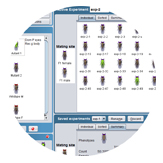
 Dr. Julie Schell and Dr. Brian Lukoff
Dr. Julie Schell and Dr. Brian Lukoff
Title: Peer Instruction 2.0: The Next Generation of Catalyzing Learner Engagement in STEM Classrooms
Group Meeting Date & Time: Thursday, May 10, 2012 @ 2:00 pm
View the slides from the group meeting
Dr. Julie Schell and Dr. Brian Lukoff are both Postdoctoral Fellows in Professor Eric Mazur’s Physics Education Research Group at Harvard University. Dr. Schell received her Doctorate from Teachers College at Columbia University and has an M.S. in Counseling and Educational Psychology with an emphasis in Instructional Technology from the University of Nevada at Reno. Dr. Schell’s current research laboratory is the undergraduate STEM classroom, where she investigates the assessment, diffusion and uptake of pedagogical innovation across the globe. She is an expert in Peer Instruction, which is an evidence-based teaching method developed by Eric Mazur and is the Co-Founder of Peer Instruction Network, a global community of Peer Instruction users. Dr. Brian Lukoff received his Ph.D. in Learning Sciences and Technology Design from the Stanford University School of Education, where he studied the use of technology to improve assessment and measurement. He also holds an M.S. in statistics from Stanford University and a B.A. in mathematics from Cornell University. Dr. Brian Lukoff’s research focuses on developing technology to drive formative assessment and student engagement, particularly in large lecture classes. He is also the CEO and co-founder of Learning Catalytics, a company that is commercializing the interactive teaching technology developed in the Mazur Group and making it available to instructors both in K-12 and higher education. In their group meeting, Dr. Schell and Dr. Lukoff spoke about Peer Instruction and enhancing STEM learning with a revolutionary online, peer-instruction tool, called Learning Catalytics.
The STEM fields are marred with ineffective learning and lack of retention of students. More specifically, students are not learning effectively and, as a result, are leaving STEM fields for non-STEM majors or are graduating without the necessary preparation for a STEM career. Conversely, instructors are not providing the necessary preparation and inspiration to inspire students to pursue a STEM career. To address these issues, Professor Eric Mazur has instituted interactive teaching in his introductory physics course at Harvard University. Interactive teaching is far from a new concept; Charles Eliot said “[Science] should be taught…not from books merely, not from memory chiefly, but by the seeing eye and the informing fingers” in his inaugural speech as Harvard University President in 1869. Taking this message in stride, Mazur and his group have revolutionized the classroom and “flipped” the direction of typical teaching oratory so that it is now amongst the students and from student to instructor.
Interactive teaching is paramount in the “flipped” classroom. The importance of the flipped classroom is two fold. First, the instructor uncovers, in contrast to covers, material in class that has previously been reviewed by the students prior to attending class. To ensure that the students complete the assignment before class, students are required to answer two concept-based questions and one question designed to reveal the most interesting and/or confusing material. Based on the answers to this latter question, Prof. Mazur and his group specifically select material to cover in class that addresses the most prevalent misconceptions. This “Just-In-Time” teaching method enables the instructor to specifically personalize each class to enhance students’ learning of key concepts in the most effective manner.
Second, students teach each other material during class by participating in peer instruction. Following a short overview of a concept, the instructor poses the first ConcepTest to assess each student’s learning. Each student answers and submits their answer using clickers. Depending on the overall results to the question, the instructor can choose to review the material again, continue to the next concept, or ask students to participate in a peer discussion and re-submission of answers (See Figure 1).
To implement peer instruction and interactive teaching in the classroom, instructors require a way to obtain answers from each student in the class. This process has evolved from raising hands, to displaying flash cards, and to clicker response systems. Such audience response systems benefit from the relative anonymity that are provided with these systems, but are limited to multiple-choice questions and limited productivity of some peer instruction groups. As a result, Dr. Lukoff, along with Professors Eric Mazur and Gary King, developed a new interactive teaching and peer instruction technology, termed Learning Catalytics. Learning Catalytics was first implemented in Prof. Mazur’s course at Harvard University in 2011 and the effort has now been commercialized in a start-up company to better address the widespread needs of interactive instruction.

Figure 2. Learning Catalytics enables instructors to monitor student responses to non-multiple choice questions in real time.
Learning Catalytics is a cloud-based technology where students are asked to “bring your own device” (“BYOD”) to participate in active learning in the classroom. Learning Catalytics can be used on any web-enabled device, such as a laptop, tablet, or phone. Learning Catalytics has several components that truly make it a model peer instruction tool. First, Learning Catalytics enables instructors to pose non-multiple choice questions to their students. Learning Catalytics contains 15 different types of questions, including but not limited to, multiple choice, word choice, paragraph response, and graphing questions. The non-reliance on multiple-choice questions means that the instructor does not have to anticipate all the incorrect answers students may come up with. It also eliminates the “expert blind spot” phenomenon where instructors, or experts within a field, no longer remember the misconceptions they held when learning specific concepts. Second, Learning Catalytics contains technology to track student responses in real time, which means that the instructor can analyze the results as students submit them. Third, using technology similar to selecting airplane seats, Learning Catalytics tracks where each student is sitting in the class. Learning Catalytics will assign intelligent pairings to form the most productive peer instruction discussion groups. Fourth, Learning Catalytics contains a resource library for instructors interested in interactive teaching to utilize, as well as contribute to, in their own classrooms. Learning Catalytics is now utilized in K-12 as well as higher education learning classrooms around the world and dramatically lessons the hurdle to incorporate interactive teaching in the classroom. (See Figure 2.)
After introducing the audience to Learning Catalytics, Dr. Schell and Dr. Lukoff enabled the group meeting attendees to experience this revolutionary peer-instruction technology firsthand. This demonstration illustrated how easy it is to set up a Learning Catalytics account, design questions, and implement the questions in the classroom. Dr. Lukoff created two questions to illustrate two different types of questions that can be used in Learning Catalytics. The first question asked attendees to locate the nucleus in a figure of a cell, while the second question asked attendees to draw a curve that solved the integral of an equation. Both questions highlighted the immense freedom in questions that can be posed to students during class. During their group meeting, Dr. Schell and Dr. Lukoff impressed upon the group meeting attendees about the importance of active, engaged learners in STEM field retention. The Mazur Group and Learning Catalytics and their immense wealth of expertise in peer instruction are rapidly changing the emerging face of education.





